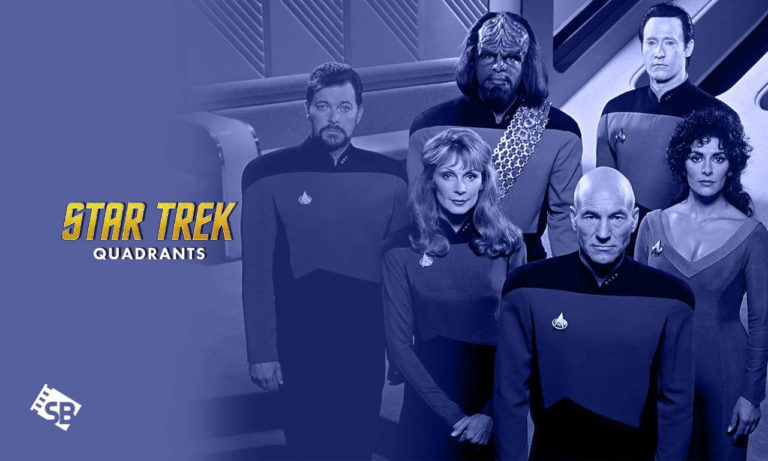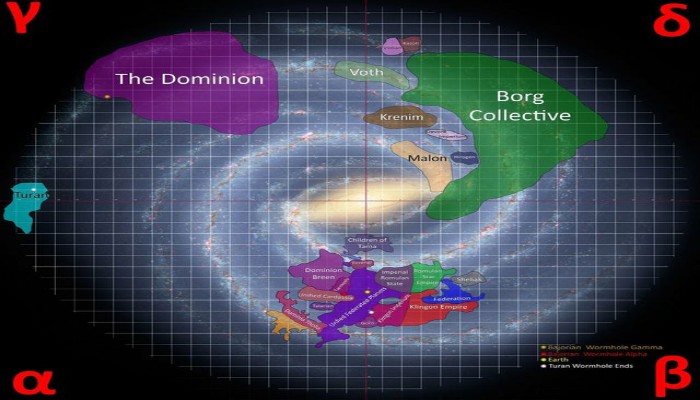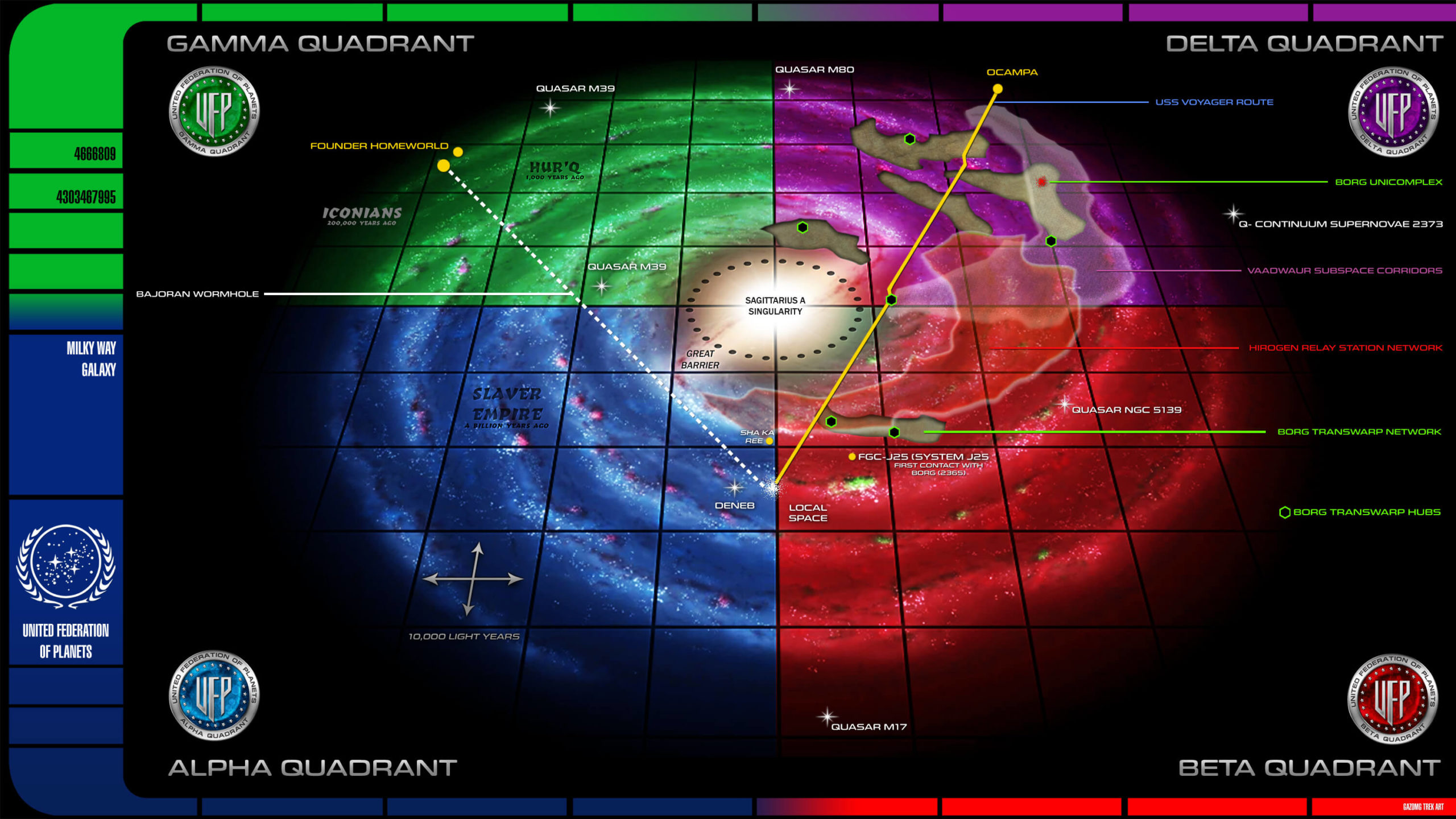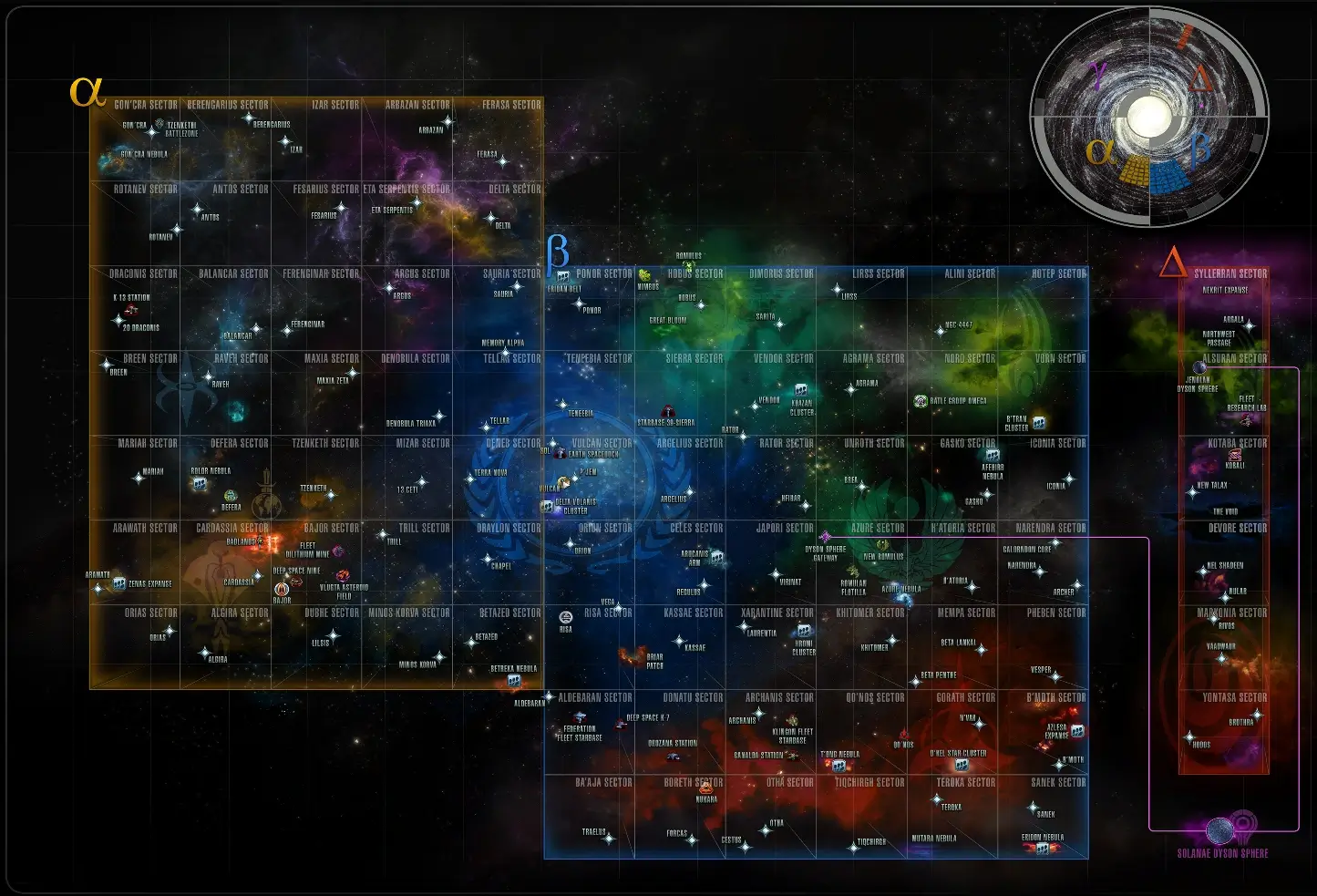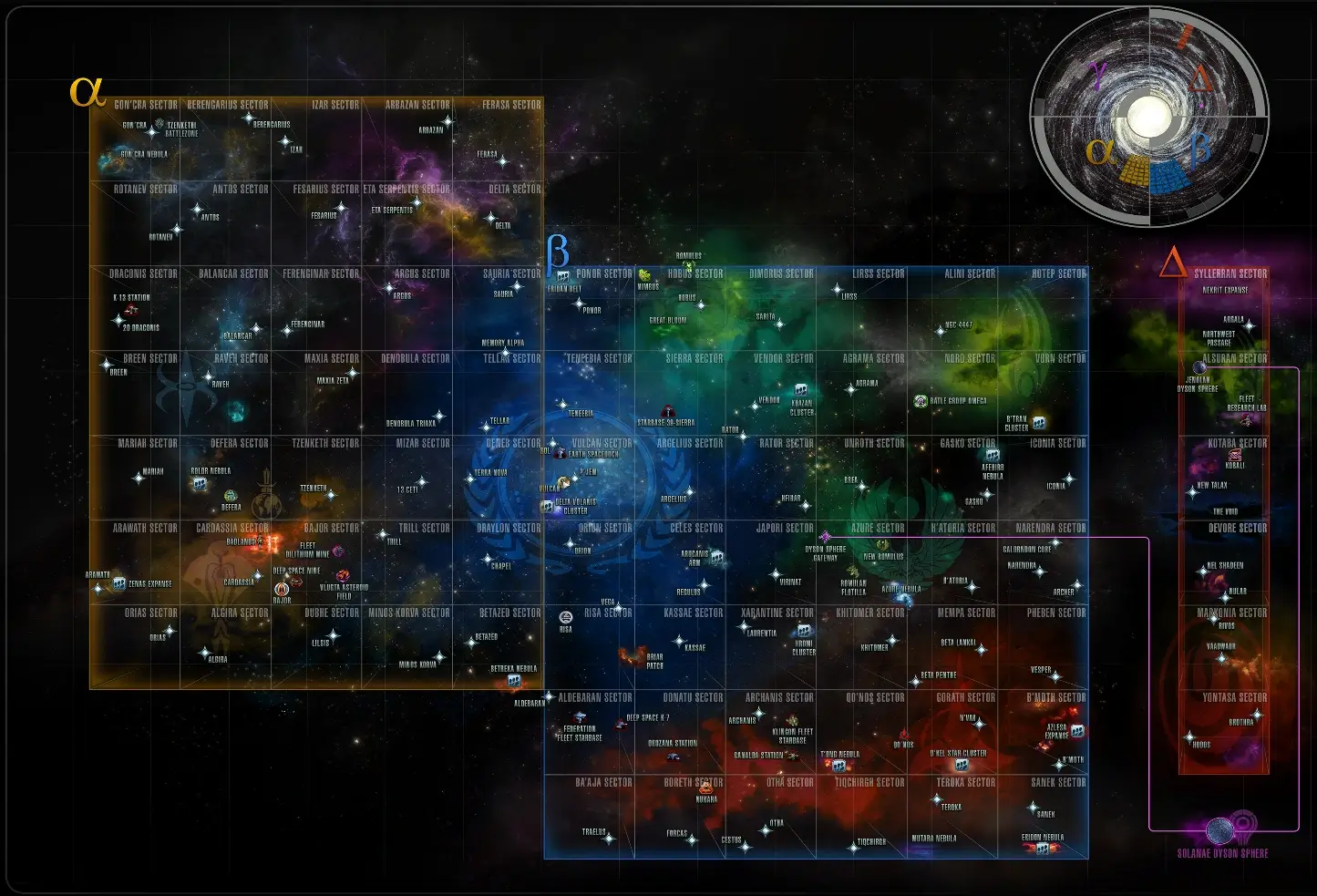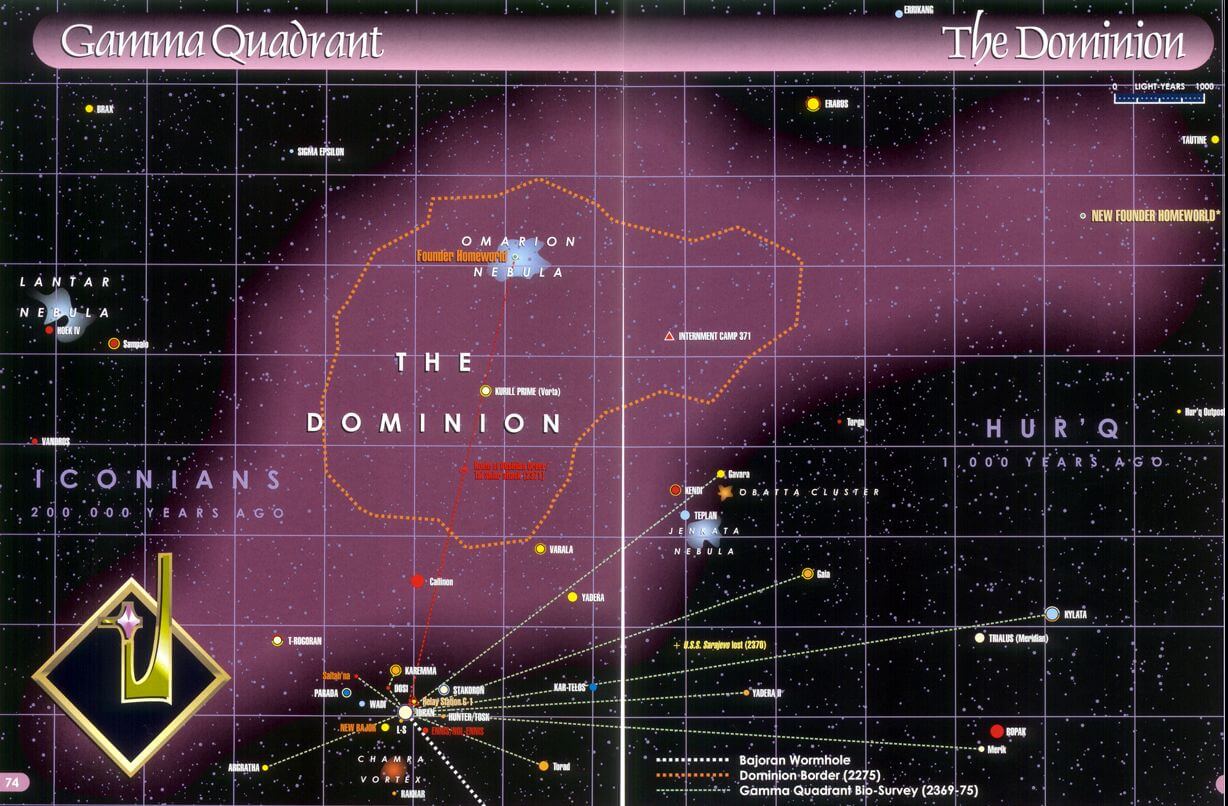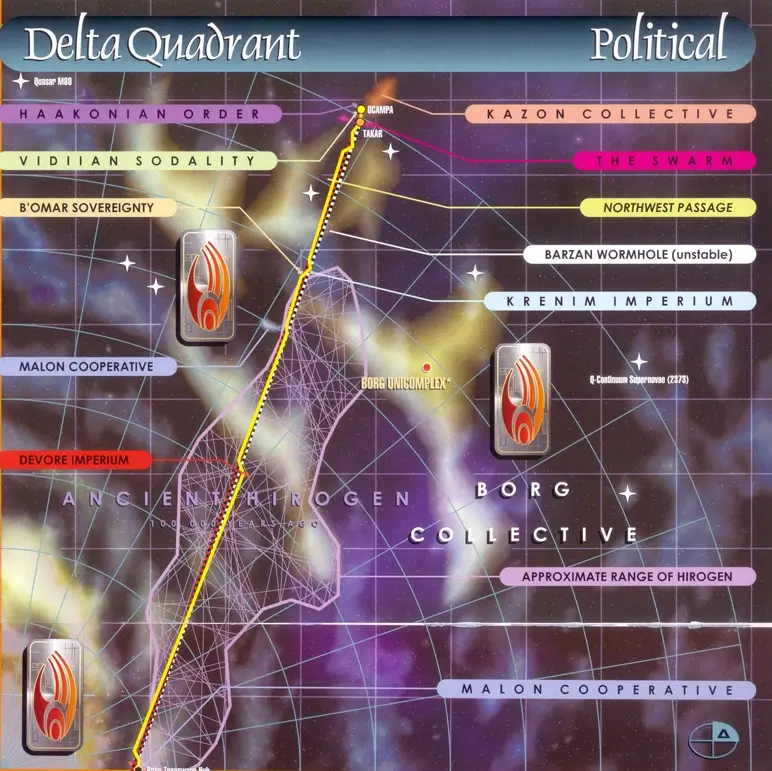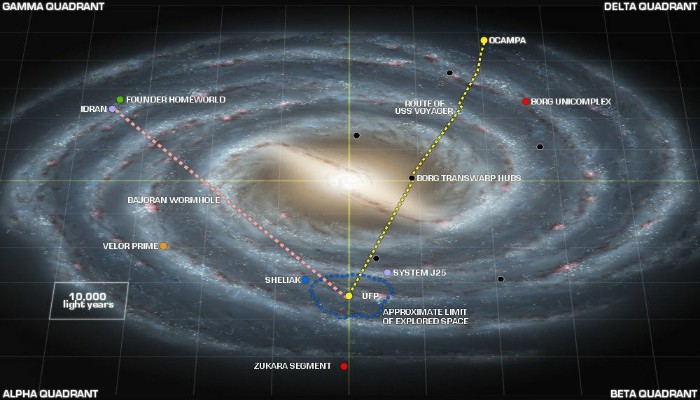What Is A Star Trek Quadrant?
According to the Star Trek Quadrants map in the universe, the “galactic quadrants” are defined by an imaginary meridian that runs across our solar system, which is similar to the concept employed by astronomers.
Instead of going via the Sun as in astronomy, the perpendicular axis in the Star Trek map of quadrants goes through the galactic center.
Accordingly, Star Trek’s quadrant system is less geocentric than normal cartography. In addition, the Greek letters Alpha quadrant star trek, Beta, Gamma, and Delta are used to denote them in the Star Trek galaxy map rather than ordinals, as in the movies.
Star Trek Quadrants Explained
Background Of The Star Trek Quadrants?
To prepare for the invasion, trans-dimensional entities in the Expanse erected cloaked moons in the area. Their objective was to change the fabric of space in the region, making it hospitable for the Sphere Builders thousands of years ago.
Within a cluster of spheres 700 million kilometers in diameter, a portion of the Expanse has already been transformed into a boiling, organic-looking soup of subatomic particles. One or more spheres provide a command function for the network, which uses artificial intelligence.
As they are hidden, the actual number of spheres is unknown. Thousands of spheres, according to Trianon’s belief. They concluded that there were at least seventy-eight spheres on the star trek Galaxy map and that Degra was one of them.
The Expanse is referred to as the “Chosen Realm” by the Triannons, and their religion is based on the spheres and their mythology. After being stranded in 2037, the spaceship Enterprise from 2154 becomes a generational ship, devoted to fighting the Xindi menace that will emerge in 2150.’s future.’
In 2133, a party of Klingons ventures into the Expanse, only to return anatomically flipped (and still alive). Vulcan ships Seleya and Vaankara also try to investigate the area without success.
The crew of the Seleya, who had been exposed to Trillium-D, were found to be insane and consequently exterminated. Earth’s Starfleet ship Enterprise (NX-01) enters the Expanse in roughly June 2153 in an attempt to find the Xindi.
Later in the year, the Andorian ship Kumari joins the fleet. Reverting twisted space to its original shape and progressively dissolving the thermobaric cloud barrier, the Enterprise destroyed the network of Spheres on February 13, 2154.
As a result of this, the Expanse fades away into obscurity. Even though a scenario is given to Captain Jonathan Archer of the Enterprise in which the Expanse becomes a significant danger to the future United Federation of Planets, this certainly seems to be removed by the effective destruction of the Spheres. The galaxy is commonly divided into four quadrants, the Alpha Quadrant, the Beta Quadrant, the Gamma Quadrant, and the Delta Quadrant which can be seen if you watch Star Trek movies in order.
Star Trek: The Major Quadrants
According to common belief, the Milky Way Galaxy is divided into four equal-sized cubic quadrants, each defined by a meridian that passes through the galactic center and a second meridian that runs perpendicular to the first and goes through the galactic core.
The four quadrants of the equilateral triangle are known as the Alpha Quadrant, Beta Quadrant, Gamma Quadrant, and Delta Quadrant in mathematics.
The Alpha and Beta Quadrants, respectively, were dominated by alliances with the United Federation of Planets and its bordering powers, such as the Klingon and Romulan Empires.
The Borg Collective and the Dominion, on the other hand, were centered in the Delta and Gamma Quadrants, respectively.
The cosmos appeared to cease to exist for a brief while in the year 2267 when Lazarus and anti-Lazarus began switching places with one another.
Captain Kirk correctly noted in his report that the effects could be felt across the whole quadrant of space. According to Starfleet Command’s Commodore Barstow, afflicted areas covered every quadrant of the Galaxy and far beyond.
Alpha Quadrant
Except for Voyager and Deep Space Nine, the bulk of the franchise’s episodes take place inside the Alpha quadrant of Star Trek of the Galaxy. The planet Earth and a substantial section of the United Federation of Planets may be found here.
Because the planet Earth is situated inside this sector, the great majority of the journey conducted by starships seen in television shows and films takes place within this quadrant.
The Star Trek quadrants, on the other hand, are not bound to a certain area of the Galaxy. This seems to be among the most well-known spot on the face of the planet.
The planets of Trill, Tellar, and Betazed may all be found in this quadrant, along with our solar system, which makes up the whole quadrant.
Some claim that the Alpha sector contains remnants of the Romulan and Klingon civilizations, while others assume the opposite.
Beta Quadrant
The Beta quadrant contains the rest of the Federation, much as the Alpha quadrant does. This implies that similar to Alpha, many television episodes and movies are set in this sector of the Galaxy.
The vast majority of the Romulan and Klingon empires are concentrated in this area. Beta is also home to Andoria, Risa, Vulcan, and Rigel. Certain publications claim that the Romulan and Klingon empires are entirely contained to a Beta quadrant and do not cross into the Alpha quadrant. These sources are incorrect.
Gamma Quadrant
The Star Trek Gamma quadrant was only partially explored until a wormhole was found in the Bajor area in the Alpha quadrant, which allowed for more extensive exploration.
It made it possible for individuals from Alpha to get to Gamma without having to spend years and years traveling.
The Federation was able to communicate with the Dominion via this wormhole, which was dubbed the Bajoran wormhole by the Federation.
This is the foe that we come up against in the television series Deep Space Nine. They are also in charge of the wormhole, which they created.
Delta Quadrant
Most of the galaxy’s Delta Quadrant area has gone mostly undiscovered. Reliving their routes back to Earth took the crew of the USS Voyager years to complete.
Return to the beginning location by drawing a straight line from the Alpha and Beta quadrants.
Before the Borg landed in the Delta quadrant, this part of the Milky Way was widely considered to be the home of the Borg. Voyager discovered when returning to Earth that it’s also the homeland of the Kazon, Vidiians, Hirogen, and Species 8472.
Star Trek: The Minor Quadrants
During the 23rd and 24th centuries, smaller parts of space in the Galaxy were called quadrants, which were smaller sections of space inside the Galaxy. Among them were the Quadrant 9, Quadrant 448, Quadrant 904, the Morgana Quadrant, and the Drema Quadrant.
Quadrant 9
Quadrant 9 is a geographical location in space. This quadrant included a part of the Neutral Zone, which was positioned far enough from Ferengi Alliance territory and protected from attack. As of 2364, there has been no recent evidence of Romulan activity in the area.
Quadrant 448
Quadrant 448 was the site of a renegade comet that had just passed through Gamma Hydra IV in 2267, according to Stardate 2267.
Before the present standardization of the quadrant/sector paradigm of celestial cartography, the word “quadrant” refers to a region of the sky.
Quadrant 904
Quadrant 904 was in space in the Milky Way Galaxy, home to several planets. There was a star desert to be found in this area. According to the most recent known data, when the USS Enterprise was first seized by the planet Gothos in this position is 2267, the ship was eight days distant from the planet Beta VI at warp factor three, and Earth was nine hundred light-years away. The Quadrant 904 Central Station served as an embarkation point and a destination for commercial transportation in 2328.
Morgana Quadrant
As per MemoryAlpha, in space, the Morgana Quadrant was a geographical location. Uncrewed Federation ships have already sailed through this area in the early years of the twenty-first century.
During a star-mapping mission that year, the USS Enterprise-D was going to the Morgana Quadrant when it met the lifeform known as Nagilum, a first for the Enterprise-D.
The Enterprise-D was the first human Federation vessel to explore this region when it arrived in 2254.
Wrapping Up
In the science fiction television series Star Trek and its spin-offs, a galactic quadrant is a region of the Milky Way Galaxy explored.
The original Star Trek helps to allude to a region that could be interchanged with a sector. Star Trek: The Next Generation and its spin-off programs and films, on the other hand, relate to a system of four galactic quadrants, denoted by the Greek letters Alpha, Beta, Gamma, and Delta in the original series. Each quadrant may be subdivided into sectors, which can be further subdivided.
It’s difficult to estimate the true extent of Star Trek Quadrants because of the large number of variables involved. The human characters in the series have explored a tiny portion of the world.
On the other hand, they have encountered races of aliens that have journeyed around the cosmos, so enlarging it for them. Hopefully, this article has given you a better understanding of exactly how large the Star Trek universe is and how we came to know about it.
